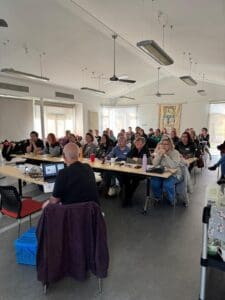The Koala (Phascolarctos cinereus), with its endearing appearance and gentle demeanor, is a beloved symbol of Australian wildlife and a significant resident of the Macedon Ranges 2. While they were once hunted to near extinction in the early 1900s, koalas were reintroduced to Victoria, including our region, and efforts continue to ensure their survival 6.
Koalas are easily recognized by their large, round head, big furry ears, and prominent black nose 34. Their fur is typically grey-brown in color with white fur on the chest, inner arms, ears, and bottom 34. They have no fur on their nose or the palms of their paws, which have rough pads and sharp claws perfectly adapted for climbing smooth-barked gum trees 34. They have two opposable thumbs on their fore paws, providing an excellent grip 34. Koalas have poor vision but rely heavily on their excellent hearing and acute sense of smell to navigate their environment and find their favorite food trees 34. Adult male koalas are noticeably larger than females, with a broader face, a distinctly larger black nose, and a prominent scent gland on their chest which they use to mark trees 34. Female koalas have a backward-facing pouch for carrying their young 34. Interestingly, koalas share a close evolutionary relationship with wombats, including the backward-facing pouch 34.
Koalas in Victoria tend to be larger and have thicker fur than those in Queensland 34. Adult female koalas in Victoria average around 8.5kg, while adult males can weigh up to 12kg 34. The fur on a koala’s bottom has a ‘speckled’ appearance, which helps them blend in with the trees 34. Their droppings, small green-brown fibrous pellets, are often a good indicator of their presence in a tree 34.
In Victoria, koalas occupy a broad range of environments, from wet coastal woodlands to foothill forests and plains woodlands 35. They are widespread in lowland and foothill forests and woodlands across southern, central, and north-east Victoria where the annual rainfall exceeds about 500 mm 35. The Macedon Ranges, with its diverse eucalyptus forests, provides suitable habitat for koalas 8. They are arboreal mammals, spending most of their lives in trees and only occasionally descending to the ground to move between them 34.
Koalas are folivore specialists, with a diet consisting mainly of eucalyptus leaves and occasionally the leaves of other plant species 6. Their digestive system is specially adapted to tolerate the toxins present in eucalyptus leaves, which can be poisonous to most other animals 36. They can sleep for up to 20 hours a day due to their low-energy diet and the significant energy required to break down these tough leaves 37. Koalas are mostly active at night (nocturnal) and around dawn and dusk 37.
Despite being reintroduced to Victoria, koala numbers appear to be decreasing due to a variety of threats 6. Habitat destruction and fragmentation remain major concerns, reducing the availability of their food trees and safe corridors for movement 6. Road accidents and attacks by pet dogs also pose significant risks, particularly when koalas are on the ground 6. Disease is another factor contributing to their decline 6. Wildlife-friendly fencing is crucial in areas where koalas are present to prevent entanglement and allow for safe passage 7.
The Macedon Ranges Wildlife Network is actively involved in koala conservation through rescue and rehabilitation efforts 1. We also work to raise community awareness about the importance of protecting koala habitat and mitigating threats 1.
You can help koalas in the Macedon Ranges by improving their habitat through planting healthy, mature eucalyptus trees that provide food and shelter 6. Drive carefully in areas where koalas are known to live, especially at night 7. Keep pet dogs under control to prevent attacks 6. Consider implementing wildlife-friendly fencing on your property 7. Report any sick, injured, or orphaned koalas to the Macedon Ranges Wildlife Network or Wildlife Victoria 7. By taking these actions, we can all contribute to the long-term survival of this iconic species in the Macedon Ranges.


